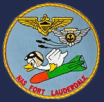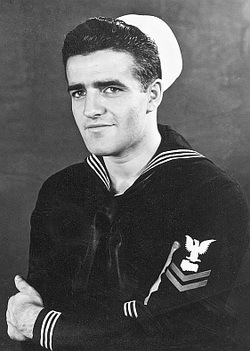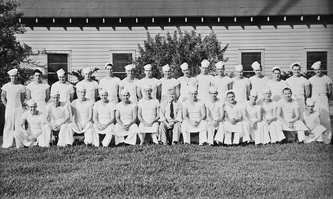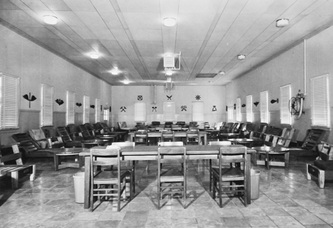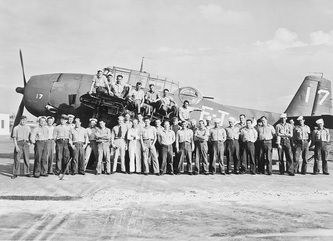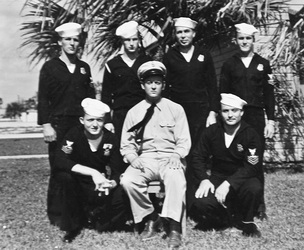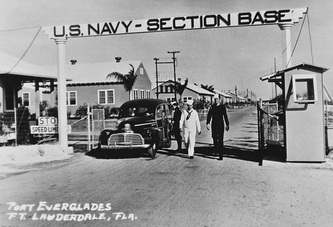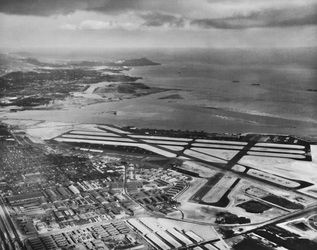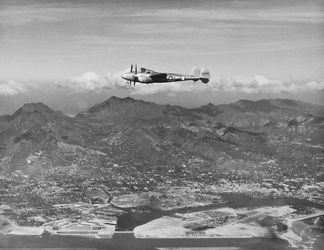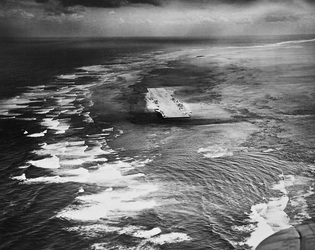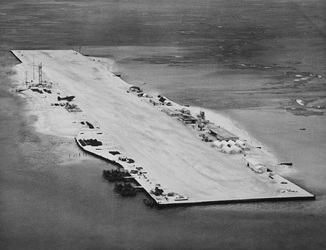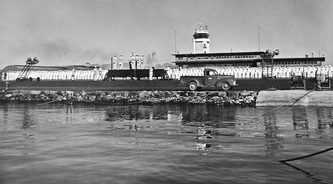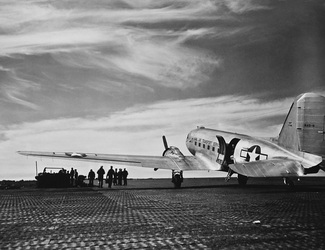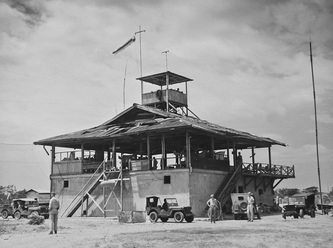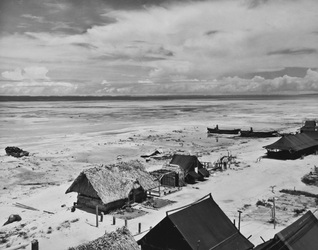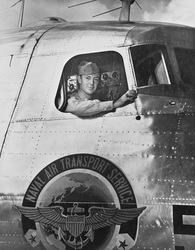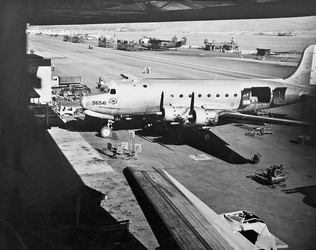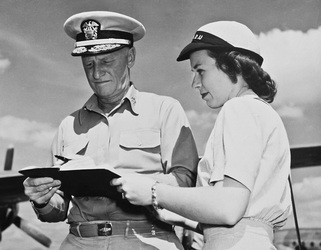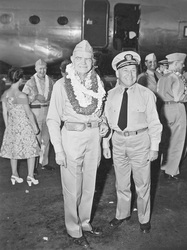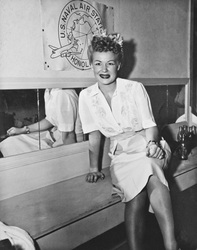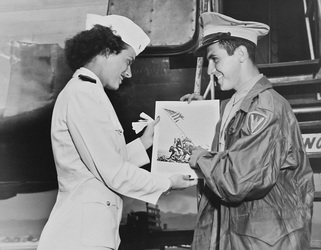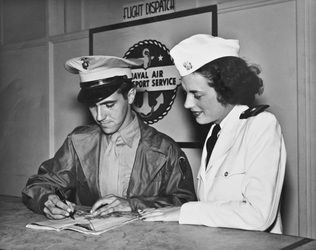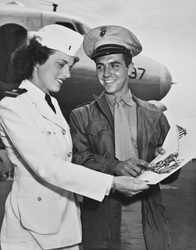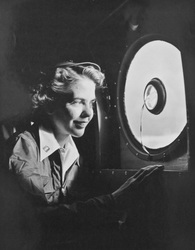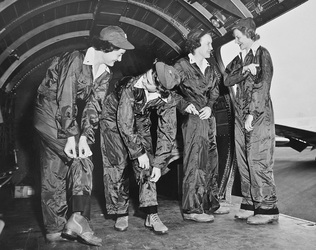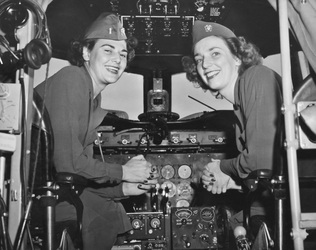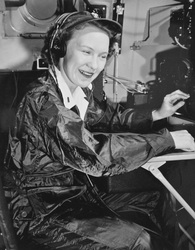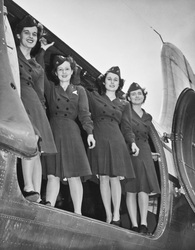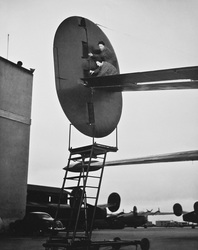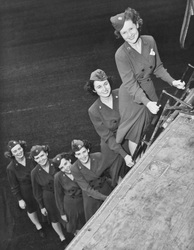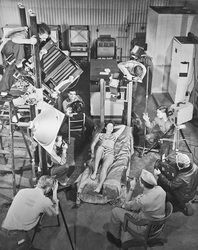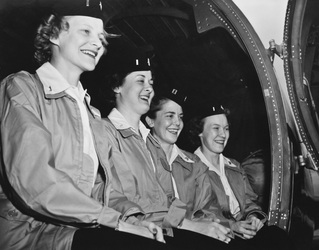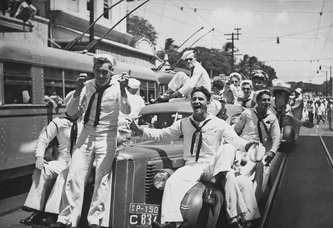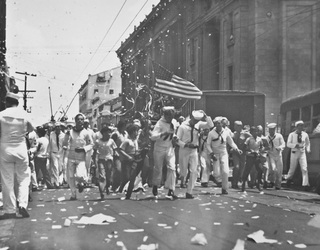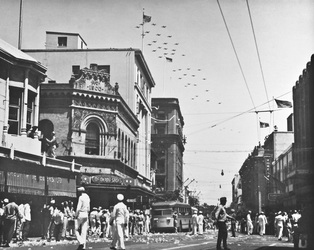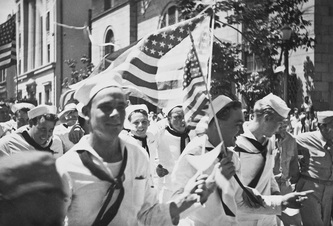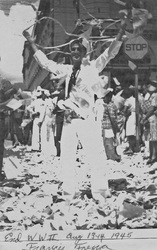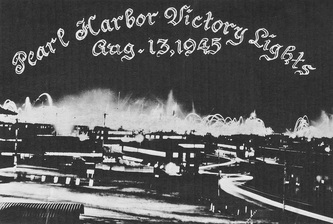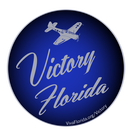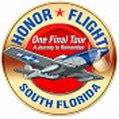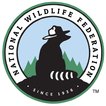Naval Air Station Fort Lauderdale
& Naval Air Station Honolulu
Francis "Frank" Frezza USNR
Reconnaissance Photographer WWII
Francis “Frank” Frezza is a native of New York. He arrived at Naval Air Station Fort Lauderdale in 1943, and was initially assigned duty cleaning the cook's barracks. Frank was an easygoing fellow and made lots of friends quickly. While at the base, he met Joe Chefitz, a professional civilian photographer. Joe arranged for Frank to get assigned to the photo unit where he worked. Together, they recorded life on the base with their photography. They would also accompany pilots on their training missions. Many of their photographs were used for brochures and for training. Frank's experience grew with each mission.
In 1944, his friend Joe was assigned to take professional photos of NASFL's Captain Pratt in his uniform. Some time later that year, Captain Pratt, Joe, and Frank were transferred to Hawaii. Captain Pratt went on to command a small carrier, which on an unfortunate mission was hit and sunk, however he was able to survive. Joe who had swapped places from another carrier, went down with the ship. Meanwhile in NAS Honolulu, Frank worked at Admiral Chester W. Nimitz' Office, and continued learning all he could about photography, in a way, to honor his friend Joe. Then he was selected to be a part of the JICPOA (Joint Intelligence Center Pacific Ocean Area), or better known as the “Silver's Gang”— a group of about 180 Navy photographers that became instrumental for reconnaissance. They worked tirelessly, and in 3 months they would have between them 2 ½ million pictures. Their missions included taking aerials, beach charts, moon charts, tide charts, and they would also come to photograph island invasions in the pacific theater, including Iwo-Jima. On the final days of the war, they recorded in images, the site of the atomic bombs—two days after they were dropped. On their down time, they would focus on photographing life on the base, as more and more women joined the service, and their contributions to the success of the war had to be recorded. Frank also took pictures of several celebrities visiting the Honolulu base in support of the troops. Also, Frank was there when Rene Gagnon who was the youngest survivor and one of the men who carried the flag up Mt. Suribachi arrived at NAS Honolulu before he was ordered to Washington, D.C. Gagnon was the first survivor to arrive back in the United States.
After the war, Frank decided to become a Detective Photographer for the New York Police Department. He retired in 1971 after 23 years on the force and moved to Colorado Springs, Colorado, where he became a businessman. He'll be 88 yrs old this year. He's semi-retired now and lives with his wife Maria, who are both avid hunters and fishermen. Frank has donated a large cache of photographs to the NASFL Museum, which are currently being curated. Several of them are on display. Below, is a small sampler of the many images Frank took during his time in the service.
All images Copyright © NAS Fort Lauderdale Museum
- Click on thumbnails to enlarge and read descriptions -
- Click on thumbnails to enlarge and read descriptions -
Rene Arthur Gagnon
Photos taken by Frank Frezza in April 1945 at NAS Honolulu. Rene Gagnon was the youngest survivor and one of the men who carried the flag up Mt. Suribachi. He was the first survivor to arrive back in the US. Gagnon was one of the U.S Marines immortalized by Joe Rosenthal's famous World War II photograph Raising the Flag on Iwo Jima. These historic photographs were taken when he arrived at NAS Honolulu before he was ordered to Washington D.C.
Photos taken by Frank Frezza in April 1945 at NAS Honolulu. Rene Gagnon was the youngest survivor and one of the men who carried the flag up Mt. Suribachi. He was the first survivor to arrive back in the US. Gagnon was one of the U.S Marines immortalized by Joe Rosenthal's famous World War II photograph Raising the Flag on Iwo Jima. These historic photographs were taken when he arrived at NAS Honolulu before he was ordered to Washington D.C.
World War II WAVES & WASP
The WAVES were a World War II-era division of the U.S. Navy that consisted entirely of women. The name of this group is an acronym for "Women Accepted for Volunteer Emergency Service" (as well as an allusion to ocean waves); the word "emergency" implied that the acceptance of women was due to the unusual circumstances of the war and that at the end of the war the women would not be allowed to continue in Navy careers. The official title was US Naval Reserve (Women's Reserve), but the title of WAVES stuck.
The WAVES began in August 1942, when Mildred McAfee, President of Wellesley College, was sworn in as a Naval Reserve Lieutenant Commander, the first female commissioned officer in U.S. Navy history, and the first director of the WAVES. This occurred two months after the WAAC (Eleanor Roosevelt convinced Congress to authorize a women's component of the Navy.
The WASP
The Women Airforce Service Pilots (WASP) and its predecessor groups the Women's Flying Training Detachment (WFTD) and the Women's Auxiliary Ferrying Squadron (WAFS) (from September 10, 1942) were pioneering organizations of civilian female pilots employed to fly military aircraft under the direction of the United States Army Air Forces during World War II. The WFTD and WAFS were combined on August 5, 1943, to create the paramilitary WASP organization. The female pilots of the WASP would end up numbering 1,074, each freeing a male pilot for combat service and duties. The WASP flew over 60 million miles in all, in every type of military aircraft. WASPs were granted veteran status in 1977, and given the Congressional Gold Medal in 2009. Twenty-five thousand women applied to join the WASP, but only 1,830 were accepted and took the oath, and out of those only 1,074 women passed the training and joined.
On his downtime, Frank Frezza was able to photograph life at the NAS Honolulu base, as more and more women joined the service, and their contributions to the success of the war had to be recorded.
The WAVES began in August 1942, when Mildred McAfee, President of Wellesley College, was sworn in as a Naval Reserve Lieutenant Commander, the first female commissioned officer in U.S. Navy history, and the first director of the WAVES. This occurred two months after the WAAC (Eleanor Roosevelt convinced Congress to authorize a women's component of the Navy.
The WASP
The Women Airforce Service Pilots (WASP) and its predecessor groups the Women's Flying Training Detachment (WFTD) and the Women's Auxiliary Ferrying Squadron (WAFS) (from September 10, 1942) were pioneering organizations of civilian female pilots employed to fly military aircraft under the direction of the United States Army Air Forces during World War II. The WFTD and WAFS were combined on August 5, 1943, to create the paramilitary WASP organization. The female pilots of the WASP would end up numbering 1,074, each freeing a male pilot for combat service and duties. The WASP flew over 60 million miles in all, in every type of military aircraft. WASPs were granted veteran status in 1977, and given the Congressional Gold Medal in 2009. Twenty-five thousand women applied to join the WASP, but only 1,830 were accepted and took the oath, and out of those only 1,074 women passed the training and joined.
On his downtime, Frank Frezza was able to photograph life at the NAS Honolulu base, as more and more women joined the service, and their contributions to the success of the war had to be recorded.
- Click on thumbnails to read descriptions -
The End of World War II
Frank Frezza was still stationed at NAS Honolulu, when the war finally ended.
He shot these photographs, on Main Street downtown Honolulu, 1945.
He shot these photographs, on Main Street downtown Honolulu, 1945.
Museum's Books | Memberships | Newsletter | NASFL History | Flight 19 | Memorial | Volunteer | Media Kit
|
Copyright © NAS Fort Lauderdale Museum
For use of images or text please contact webmaster Website created by Moonrisings, August 3, 2010 |
